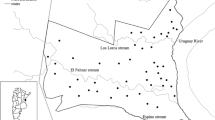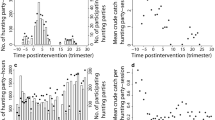Abstract
Uncoordinated and isolated control programs are often used by land managers, property owners and recreational hunters to control numbers and reduce the impacts of European red foxes (Vulpes vulpes). However, decades of such attempts to eradicate this significant agricultural and biodiversity pest in many countries have failed. We investigated the effectiveness of an uncoordinated and isolated shooting program to determine if it caused any change in red fox population density. We also determined whether shooting is more cost effective than poison baiting for fox control. First, we estimated the density of foxes on an agricultural study property using distance sampling and rates of bait uptake before and after a control program. Second, we estimated the costs associated with undertaking the control program and compared it to the estimated costs of undertaking poison baiting. Prior to control, we estimated a density of 4.18 foxes per square kilometre. After the control exercise, which removed 47 individuals in 12 nights, we estimated a density of 3.26 foxes per square kilometre. Our results provide evidence that one-off control programs are not effective in greatly reducing red fox density, even if the control effort is intensive. Where large-scale control programs cannot be coordinated, isolated programs should therefore involve follow-up campaigns to reduce population recovery. On a local scale, combinations of shooting and baiting may also provide maximum control impact at minimal cost.





Similar content being viewed by others
References
Baker PJ, Harris S (2006) Does culling reduce fox (Vulpes vulpes) density in commercial forests in Wales, UK? Eur J Wildl Res 52:99–108
Baker PJ, Funk SM, Harris S, White PCL (2000) Flexible spatial organization of urban foxes, Vulpes vulpes, before and during an outbreak of sarcoptic mange. Anim Behav 59:127–146
Bubela T (1995) Social effects of sterilising free-ranging vixens (Vulpes vulpes) in subalpine Australia. PhD Thesis, University of Sydney
Buckland ST (1985) Perpendicular distance models for line transect sampling. Biometrics 41:177–195
Buckland ST, Anderson DR, Burnham KP, Laake JL (1993) Distance sampling: estimating abundance of biological populations. Chapman and Hall, London
Burbidge AA, McKenzie NL (1989) Patterns in the modern decline of Western Australia’s vertebrate fauna: causes and conservation implications. Biol Conserv 50:143–198
Coman BJ (1973) The diet of red foxes, Vulpes vulpes L., in Victoria. Aust J Zool 21:391–401
Coman BJ (1988) The age structure of a sample of red foxes (Vulpes vulpes L.) taken by hunters in Victoria. Aust Wildl Res 15:223–229
Coman BJ, Robinson J, Beaumont C (1991) Home range, dispersal and density of red foxes (Vulpes vulpes L.) in central Victoria. Wildl Res 18:215–223
Doncaster CP, Macdonald DW (1991) Drifting territoriality in the red fox Vulpes vulpes. J Anim Ecol 60:423–439
Gentle MN (2005) Factors affecting the efficiency of fox baiting practices on the central tablelands of New South Wales. PhD Thesis, University of Sydney
Gentle MN, Saunders GR, Dickman CR (2007) Poisoning for production: how effective is fox baiting in south-eastern Australia? Mammal Rev 37:177–190
Glen AS, Pennay M, Dickman CR et al (2011) Diets of sympatric native and introduced carnivores in the Barrington Tops, eastern Australia. Aust Ecol 36:290–296
Goszczynski J (2002) Home ranges in red fox: territoriality diminishes with increasing area. Acta Theriol 47:103–114
Greentree C, Saunders G, McLeod L, Hone J (2000) Lamb predation and fox control in south-eastern Australia. J Appl Ecol 37:935–943
Harding EK, Doak DF, Albertson JD (2001) Evaluating the effectiveness of predator control: the non-native red fox as a case study. Conserv Biol 15:1114–1122
Heydon MJ, Reynolds JC (2000) Demography of rural foxes (Vulpes vulpes) in relation to cull intensity in three contrasting regions of Britain. J Zool (London) 251:265–276
Heydon MJ, Reynolds JC, Short MJ (2000) Variation in abundance of foxes (Vulpes vulpes) between three regions of rural Britain, in relation to landscape and other variables. J Zool (London) 251:253–264
Hone LJ (1999) Fox control and rock-wallaby population dynamics-assumptions and hypotheses. Wildl Res 26:671–673
Lukacs PM, Anderson DR, Burnham KP (2005) Evaluation of trapping-web designs. Wildl Res 32:103–110
Marlow NJ, Thomson PC, Algar D et al (2000) Demographic characteristics and social organisation of a population of red foxes in a rangeland area in Western Australia. Wildl Res 27:457–464
McLeod R (2004) Counting the cost: impact of invasive animals in Australia, 2004. Cooperative Research Centre for Pest Animal Control, Canberra
McLeod LJ, Saunders GR, McLeod SR et al (2010) The potential for participatory landscape management to reduce the impact of the red fox (Vulpes vulpes) on lamb production. Wildl Res 37:695–701
McLeod LJ, Saunders GR, Miners A (2011) Can shooting be an effective management tool for foxes? Preliminary insights from a management programme. Ecol Manag Restor 12:224–226
National Road Motoring Association (2011) Car operating costs calculator. National Road Motoring Association. https://www.mynrma.com.au/mynrma/operating-costs-calculator.aspx. Accessed May 2012
Rushton SP, Shirley MDF, Macdonald DW, Reynolds JC (2006) Effects of culling fox populations at the landscape scale: a spatially explicit population modeling approach. J Wildl Manag 70:1102–1110
Saunders GR, Coman B, Kinnear J, Braysher M (1995) Managing vertebrate pests: foxes. Australian Government Publishing Service, Canberra
Saunders GR, Gentle MN, Dickman CR (2010) The impacts and management of foxes Vulpes vulpes in Australia. Mammal Rev 40:181–211
Sharp A, Norton M, Marks A, Holmes K (2001) An evaluation of two indices of red fox (Vulpes vulpes) abundance in an arid environment. Wildl Res 28:419–424
Thomas L, Buckland ST, Rexstad EA et al (2010) Distance software: design and analysis of distance sampling surveys for estimating population size. J Appl Ecol 47:5–14
Thompson JA, Fleming PJS (1994) Evaluation of the efficacy of 1080 poisoning of red foxes using visitation to non-toxic baits as an index of fox abundance. Wildl Res 21:27–39
Towerton AL, Penman TD, Kavanagh RP, Dickman CR (2011) Detecting pest and prey responses to fox control across the landscape using remote cameras. Wildl Res 38:208–220
Vine SJ, Crowther MS, Lapidge SJ et al (2009) Comparison of methods to detect rare and cryptic species: a case study using the red fox (Vulpes vulpes). Wildl Res 36:436–446
White PCL, Saunders G, Harris S (1996) Spatio-temporal patterns of home range use by foxes (Vulpes vulpes) in urban environments. J Anim Ecol 65:121–125
Acknowledgments
This study was funded by the University of Sydney. Much assistance was given by the managers on Arthursleigh, particularly Steve Burgun and Brian Farrell. Samantha Vine and Anthony English were most instrumental in setting up the project and providing ongoing support. Alistair Tait assisted with and provided his vehicle for the control exercise and tracking, for which we are most grateful.
Author information
Authors and Affiliations
Corresponding author
Additional information
Communicated by R. White
Rights and permissions
About this article
Cite this article
Newsome, T.M., Crowther, M.S. & Dickman, C.R. Rapid recolonisation by the European red fox: how effective are uncoordinated and isolated control programs?. Eur J Wildl Res 60, 749–757 (2014). https://doi.org/10.1007/s10344-014-0844-x
Received:
Revised:
Accepted:
Published:
Issue Date:
DOI: https://doi.org/10.1007/s10344-014-0844-x




